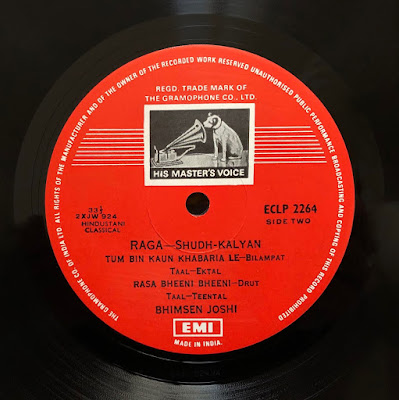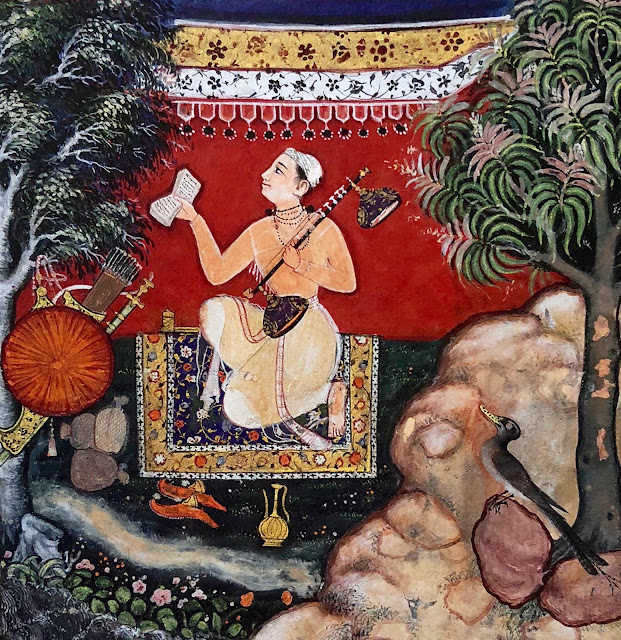Bhimsen Joshi – Raag Lalit and Raag Shush-Kalyan – His Master's Voice – ECLP 2264, 1961 (LP)

Bimsen Joshi (1922-2011) was among the greatest and most popular Hindustani Kyal singers of the second half of the 20th century. Though he did not come from a musical family, from a young age he felt such an intense passion for singing that he left his home in Karnakata at the age of 11 for two years in search of a guru in Northern India notably in Gwalior, where he met singer Krishnarao Shankar Pandit (1894–1989)* and sarod master Hafiz Ali Kahn (1888–1972) and began a stringent 12-hour-a-day musical training. Returning home he was accepted by Sawai Gandharva (1886-1952), the most famous disciple of Abdul Karim Khan (1872-1937)*, as his disciple, in 1935.
The brilliant student began performing and recording shellac 78 RPMs in the early 1940s, crafting a unique singing style influenced by great singers like Begum Akhtar (1914-1974), Kesarbai Kerkar (1892-1977)* and Amir Khan (1912-1974)*. Steeped in the time-honored tradition, Joshi also embodied a changing modern India, playing music that transcended class, caste and religion, by singing bhajan and abhang devotional songs in Kannada, Hindi and Marathi languages which brought him a large nationwide audience.
This second LP, released by the virtuoso in 1961, features Joshi’s powerful voice, dazzling improvisation techniques, and fluid creativity.
In an interview quoted in the English-language periodical India Abroad in 1997, Mr. Joshi explained his eclectic approach to his art.
“For a few years after learning music, I did not sing, I only listened; I heard a lot of music of different kinds,” he said. “This is an education which is as important as practicing music.” He added:
“The singer has to be a great thief. From each person take the best to create your own style.”**
* Listen to these luminaries here
* Listen to these luminaries here
Bimsen Joshi (1922-2011) fût
l'un des chanteurs Hindustani de Kyal les plus populaires de la seconde moitié du
XXe siècle. Bien que n’étant pas issu d’une famille de musiciens, il éprouve
une passion dévorante pour le chant dès son plus jeune âge et quitte même le
foyer familial à Karnakata seul à l’âge de 11 ans pendant deux années à la recherche d’un gourou en Inde du nord,
notamment à Gwalior, où il rencontre le chanteur Krishnarao Shankar Pandit
(1894-1989)* et le maître du sarod
Hafiz Ali Kahn (1888-1972). C’est là qu’il s’adonne corps et âme à la musique pendant plus de 12 heures
par jour. De retour chez lui, Sawai Gandharva (1886-1952), le plus
célèbre disciple du fondateur de l’école Kirana Gharana Abdul Karim Khan (1872-1937)*,
l’accepte comme son disciple en 1935.
Le brillant élève commence à se produire en public et à enregistrer des 78 tours à partir du début des
années 1940, forgeant un style de chant unique inspiré par des grandes figures comme Begum Akhtar (1914-1974), Kesarbai Kerkar (1892-1977)* et Amir Khan
(1912-1974)*. Profondément ancré dans la tradition, Joshi incarnait également une Inde
moderne en mutation. Il propose ainsi une musique qui transcende les classes sociales,
les castes et les religions, avec notamment des chants bhajans et abhang dévotionnels en kannada, en hindi et en marathi, ce qui lui valut une très grande renommée dans l'ensemble du pays.
Ce second album, publié par le virtuose en 1961, présente sa voix puissante, ses techniques d’improvisation éblouissantes et sa créativité fluide et débordante.
Ce second album, publié par le virtuose en 1961, présente sa voix puissante, ses techniques d’improvisation éblouissantes et sa créativité fluide et débordante.
Download
Photograph below is from Tales of a Parrot by Ziya al-Din Nakhshabi, Cleveland Museum of Art, 1978:
Fourteenth night: The origin of music with a mythical bird with seven holes in its beak, symbolizing the seven notes, acting as the vina player's muse, 16th century.
Please help me purchase important traditional records to pursue my global curation project and share the best finds with you on this blog:




Thank you!
ReplyDeleteGreat post. Panditji's earliest titles were the best (when he was still sober). Thanks Thomas!
ReplyDeleteTeşekkürler...
ReplyDelete